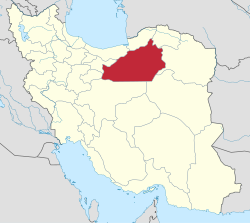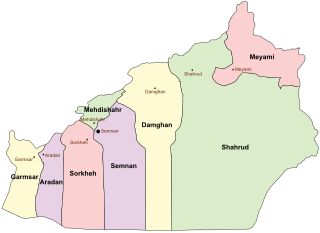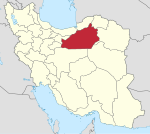Semnan province
Semnan Province
Persian: استان سمنان | |
|---|---|
 Location of Semnan province within Iran | |
 | |
| Coordinates: 35°11′N 54°25′E / 35.183°N 54.417°E[2] | |
| Country | |
| Region | Region 1[1] |
| Capital | Semnan |
| Counties | 8 |
| Government | |
| • Governor-general | Mohammad-Reza Hashemi |
| • MPs of Assembly of Experts | Mohammad Shahcheraghi |
| • Representative of the Supreme Leader | Morteza Motiei |
| Area | |
| • Total | 97,491 km2 (37,641 sq mi) |
| Population (2016)[3] | |
| • Total | 702,360 |
| • Density | 7.2/km2 (19/sq mi) |
| Time zone | UTC+03:30 (IRST) |
| ISO 3166 code | IR-20 |
| Main language(s) | Semnani languages, Persian |
| HDI (2019) | 0.807[4] very high · 4th |
Semnan province (Persian: استان سمنان)[a] is one of the 31 provinces of Iran. It is in the north of the country. Its capital is the city of Semnan.[5] The province of Semnan covers an area of 96,816 square kilometers and stretches along the Alborz mountain range, bordering on Kavir desert in its southern parts.
At the time of the 2006 National Census, the population of the province was 570,835 in 159,791 households.[6] The following census in 2011 counted 631,218 people in 186,114 households.[7] The province was made part of Region 1 following the division of the provinces into 5 regions, solely for coordination and development purposes, on June 22, 2014.[1] By the time of the most recent census of 2016, the population had risen to 702,360 in 215,571 households.[3]
Various ethnic groups with Kurdish, Turkish, Lor, Arab, Baloch and Gilak origins are settled in this province and it is also known as the Island of the Tribes due to the variety of ethnic groups living in the province.[8]
Semnan province is located on the southern slopes of the Alborz mountain range. The height of the province decreases from north to south until it reaches the desert. The area of this province is 96000 square kilometers and it is 5.6% of the area of Iran.[9]
History[edit]
Semnan can be divided into sixteen sectors from the old days of Avesta. In the Median and Achaemenid times, it accounted for being one of the largest provinces of the empires, and today it roughly corresponds to the borders of the ancient region of Parthia.
During the Islamic era, Semnan was part of the historical region of Gomess or Komesh, and the Silk Road paved its way from the midst of this region. Needless to say, the province was witness to numerous wars.
The Cultural Historical Heritage Organization of Iran lists 470 sites of historical and cultural heritage such as palaces, forts, castles, caravansarais, ab anbars, and badgirs in Semnan. In addition to these, there are various religious and sacred places as well.
Geography[edit]
The province is divided into two parts: a mountainous region and the plains at the foot of the mountains. The former offers scope for recreational activities as well as being a source for minerals, while the latter encompasses some ancient cities of Iran, including one of the capitals of the ancient Parthian Empire.
The province neighbors Golestan and Mazandaran provinces to the north, North Khorasan province to the northeast, Tehran and Qom provinces to the west, Isfahan province to the south, South Khorasan province to the southeast, and Razavi Khorasan province to the east.
Abr forest[edit]
This forest lies in Semnan province near its border with Golestan province. It is one of the oldest forests in Iran and a remnant of the third geological age. The Iranian Roads Ministry's decision to build a road through the forest sparked widespread protests last year.[when?]
The environmentalists, backed by the country's media, began a wide campaign against the ministry's decision, which finally led the Prosecutor General to order a halt in the construction of the road. However, all these efforts came to naught when it was announced in April 2008 that the government granted permission to the Roads Ministry to construct the road.[citation needed]
Administrative divisions[edit]
The population history and structural changes of Semnan province's administrative divisions over three consecutive censuses are shown in the following table.
| Counties | 2006[6] | 2011[7] | 2016[3] |
|---|---|---|---|
| Aradan[b] | — | — | 13,884 |
| Damghan | 81,993 | 86,908 | 94,190 |
| Garmsar | 77,676 | 81,324 | 77,421 |
| Mehdishahr[c] | — | 41,896 | 47,475 |
| Meyami[d] | — | — | 38,718 |
| Semnan | 186,159 | 182,260 | 196,521 |
| Shahrud | 225,007 | 238,830 | 218,628 |
| Sorkheh[e] | — | — | 15,523 |
| Total | 570,835 | 631,218 | 702,360 |
Cities[edit]
According to the 2016 census, 560,502 people (nearly 80% of the population of Semnan province) live in the following cities:v
| City | Population |
|---|---|
| Amiriyeh | 3,561 |
| Aradan | 6,257 |
| Bastam | 8,609 |
| Beyarjomand | 2,528 |
| Damghan | 59,106 |
| Darjazin | 5,997 |
| Dibaj | 5,647 |
| Eyvanki | 13,518 |
| Garmsar | 48,672 |
| Kalateh | 4,611 |
| Kalateh Khij | 5,651 |
| Kohanabad | 1,192 |
| Mehdishahr | 24,485 |
| Meyami | 4,566 |
| Mojen | 5,932 |
| Rudian | 3,770 |
| Semnan | 185,129 |
| Shahmirzad | 11,191 |
| Shahrud | 150,129 |
| Sorkheh | 9,951 |
Languages[edit]


The Semnani languages (known also as Komisenian languages) spoken in the province are a group of Northwestern Iranian languages,[14] (only 68,700 native speakers in 2019[15]) of Iran. These languages are accorded only "dialect" status in some sources. Most of the Semnani languages are descendants of the extinct Parthian while Semnani proper has been placed among the Caspian languages descended from the extinct Median.[16]
There are six Semnani languages named in the literature, these being Semnani, Biyabunaki, Sangsari, Sorkhei, Aftari and Lasgerdi - of which some may only be dialects, although there has been little published concerning the relationships between them.[17]
Semnani proper (Semnani: سمنی زفون), like other Caspian languages, bears some resemblance to the Old Iranian Median language but was influenced by Parthian in a later process.[18]
See also[edit]
- Bayazid Bastami
- Ashraf Jahangir Semnani
- Darius III
- Dasht-e Kavir
- Fath Ali Shah Qajar
- Hassan Rouhani
- Hecatompylos or Shahr-e Qumis
- Khar Turan National Park
- Mahmud Ahmadinejad
- Manuchehri Damghani
- Parthia
- Rig-e Jenn
- Sangsar (Mahdishahr)
- Seleucids
- Semnani language
- Yadollah Royaee
![]() Media related to Semnan Province at Wikimedia Commons
Media related to Semnan Province at Wikimedia Commons
Notes[edit]
- ^ Also romanized as Ostān-e Semnān
- ^ Separated from Garmsar County after the 2011 census[10]
- ^ Separated from Semnan County after the 2006 census[11]
- ^ Separated from Shahrud County after the 2011 census[12]
- ^ Separated from Semnan County after the 2011 census[13]
References[edit]
- ^ a b "استانهای کشور به ۵ منطقه تقسیم شدند". همشهری آنلاین. 22 June 2014. Retrieved 4 February 2024.
- ^ OpenStreetMap contributors (24 May 2024). "Semnan Province" (Map). OpenStreetMap. Retrieved 24 May 2024.
- ^ a b c "Census of the Islamic Republic of Iran, 1395 (2016)". AMAR (in Persian). The Statistical Center of Iran. p. 20. Archived from the original (Excel) on 17 November 2020. Retrieved 19 December 2022.
- ^ "Sub-national HDI - Area Database - Global Data Lab". hdi.globaldatalab.org. Retrieved 13 September 2018.
- ^ Habibi, Hassan (21 June 1369). "Approval of the organization and chain of citizenship of the elements and units of the national divisions of Semnan province, centered in Semnan city". Lamtakam (in Persian). Ministry of Interior, Defense Political Commission of the Government Council. Archived from the original on 2 January 2024. Retrieved 2 January 2024.
- ^ a b "Census of the Islamic Republic of Iran, 1385 (2006)". AMAR (in Persian). The Statistical Center of Iran. p. 20. Archived from the original (Excel) on 20 September 2011. Retrieved 25 September 2022.
- ^ a b "Census of the Islamic Republic of Iran, 1390 (2011)". Syracuse University (in Persian). The Statistical Center of Iran. p. 20. Archived from the original (Excel) on 20 January 2023. Retrieved 19 December 2022.
- ^ Tourism Magazine [dead link]
- ^ ایران, عصر. "از استان سمنان چه می دانید؟". asriran.com (in Persian). Retrieved 21 August 2023.
- ^ Rahimi, Mohammadreza (10 October 1392). "Aradan County was added to the map of country divisions". DOLAT (in Persian). Ministry of Interior, Board of Ministers. Archived from the original on 2 October 2013. Retrieved 23 April 2023.
- ^ Davodi, Parviz (29 July 1386). "Approval letter regarding the reforms of country divisions in Semnan province". Lamtakam (in Persian). Ministry of Interior, Political-Defense Commission of the Government Board. Archived from the original on 2 January 2024. Retrieved 2 January 2024.
- ^ Rahimi, Mohammadreza (2 June 2013). "Letter of approval regarding country divisions in Semnan province". Islamic Parliament Research Council (in Persian). Ministry of Interior, Board of Ministers. Archived from the original on 25 September 2011. Retrieved 22 November 2023.
- ^ Jahangiri, Ishaq (27 December 2019). "Letter of approval regarding Momenabad Rural District of Semnan province; and Letter of approval regarding country divisions in Semnan County, Semnan province". Qavanin (in Persian). Ministry of Interior, Council of Ministers. Archived from the original on 25 April 2023. Retrieved 22 November 2023.
- ^ "Ethnologue listing for Semnani languages". Retrieved 4 February 2024.
- ^ "Semnani | Ethnologue Free". Ethnologue (Free All). Retrieved 4 February 2024.
- ^ Pierre Lecoq. 1989. "Les dialectes caspiens et les dialectes du nord-ouest de l'Iran," Compendium Linguarum Iranicarum. Ed. Rüdiger Schmitt. Wiesbaden: Dr. Ludwig Reichert Verlag. pg. 297
- ^ C.F. & F.M. Voegelin, Classification and Index of the World's Languages (1977) lists them as dialects of Persian (pg. 185).
Lecoq, pg. 297 lists them as "dialects" as well.
Ethnologue lists Semnani, Sorkhei, Lasgerdi, and Sangsari as languages with Biyabunaki as a possible dialect of Semnani and Aftari as a dialect of Sorkhei.
Linguasphere lists them together in an outer language called Semnani+Sangisari [58-AAC-f] with Semnani and Sangisari listed as inner languages.
Merritt Ruhlen, A Guide to the World's Languages, Volume 1: Classification (1991) lists Semnani and Sangisari as languages in the Semnani subgroup. - ^ Habib Borjian: . In: . Nr. 2. Brill, 2009
External links[edit]
- History of Semnan province
- Information on Semnan National geoscience database of Iran
- Semnan Cultural Heritage Organization
- SemnanLine NEWSPORTAL
- Chisholm, Hugh, ed. (1911). . Encyclopædia Britannica (11th ed.). Cambridge University Press.


